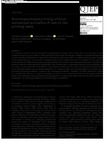Stereotype-based priming without stereotype activation: A tale of two priming tasks
| dc.contributor.author | Tsamadi, D | en |
| dc.contributor.author | Falbén, JK | en |
| dc.contributor.author | Persson, LM | en |
| dc.contributor.author | Golubickis, M | en |
| dc.contributor.author | Caughey, S | en |
| dc.contributor.author | Sahin, B | en |
| dc.contributor.author | Macrae, CN | en |
| dc.date.accessioned | 2022-02-07T14:21:41Z | |
| dc.date.available | 2022-02-07T14:21:41Z | |
| dc.date.issued | 2020-11 | en |
| dc.identifier.issn | 1747-0218 | en |
| dc.identifier.uri | http://hdl.handle.net/10026.1/18657 | |
| dc.description.abstract |
<jats:p> An extensive literature has demonstrated stereotype-based priming effects. What this work has only recently considered, however, is the extent to which priming is moderated by the adoption of different sequential-priming tasks and the attendant implications for theoretical treatments of person perception. In addition, the processes through which priming arises (i.e., stimulus and/or response biases) remain largely unspecified. Accordingly, here we explored the emergence and origin of stereotype-based priming using both semantic- and response-priming tasks. Corroborating previous research, a stereotype-based priming effect only emerged when a response-priming (vs. semantic-priming) task was used. A further hierarchical drift diffusion model analysis revealed that this effect was underpinned by differences in the evidential requirements of response generation (i.e., a response bias), such that less evidence was needed when generating stereotype-consistent compared with stereotype-inconsistent responses. Crucially, information uptake (i.e., stimulus bias, efficiency of target processing) was faster for stereotype-inconsistent than stereotype-consistent targets. This reveals that stereotype-based priming originated in a response bias rather than the automatic activation of stereotypes. The theoretical implications of these findings are considered. </jats:p> | en |
| dc.format.extent | 1939 - 1948 | en |
| dc.language | en | en |
| dc.language.iso | en | en |
| dc.publisher | SAGE Publications | en |
| dc.title | Stereotype-based priming without stereotype activation: A tale of two priming tasks | en |
| dc.type | Journal Article | |
| plymouth.issue | 11 | en |
| plymouth.volume | 73 | en |
| plymouth.journal | Quarterly Journal of Experimental Psychology | en |
| dc.identifier.doi | 10.1177/1747021820925396 | en |
| plymouth.organisational-group | /Plymouth | |
| plymouth.organisational-group | /Plymouth/Faculty of Health | |
| plymouth.organisational-group | /Plymouth/Faculty of Health/School of Psychology | |
| plymouth.organisational-group | /Plymouth/REF 2021 Researchers by UoA | |
| plymouth.organisational-group | /Plymouth/REF 2021 Researchers by UoA/UoA04 Psychology, Psychiatry and Neuroscience | |
| plymouth.organisational-group | /Plymouth/REF 2021 Researchers by UoA/UoA04 Psychology, Psychiatry and Neuroscience/UoA04 Psychology, Psychiatry and Neuroscience MANUAL | |
| plymouth.organisational-group | /Plymouth/Users by role | |
| plymouth.organisational-group | /Plymouth/Users by role/Academics | |
| dcterms.dateAccepted | 2020-04-21 | en |
| dc.rights.embargodate | 2022-02-08 | en |
| dc.identifier.eissn | 1747-0226 | en |
| dc.rights.embargoperiod | Not known | en |
| rioxxterms.versionofrecord | 10.1177/1747021820925396 | en |
| rioxxterms.licenseref.uri | http://www.rioxx.net/licenses/all-rights-reserved | en |
| rioxxterms.licenseref.startdate | 2020-11 | en |
| rioxxterms.type | Journal Article/Review | en |


